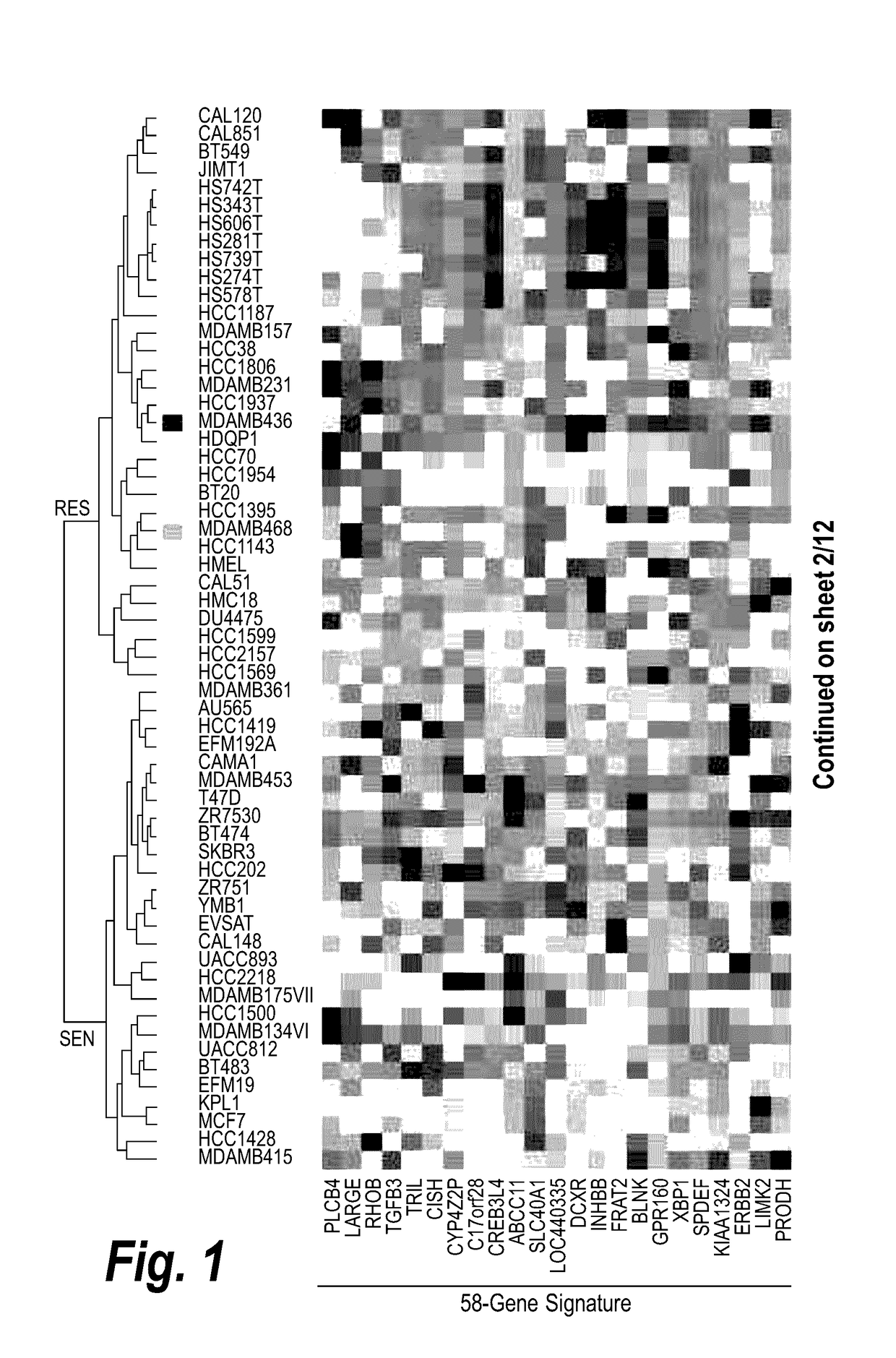Biomarkers to identify patients that will respond to treatment and treating such patients
a cancer patient and biomarker technology, applied in the field of biomarkers to identify cancer patients, can solve the problems of radiation therapy being most harmful to rapidly growing cells, cancer cells, and specifically damage the dna of cancer cells, and radiation therapy also affecting normal cells
- Summary
- Abstract
- Description
- Claims
- Application Information
AI Technical Summary
Benefits of technology
Problems solved by technology
Method used
Image
Examples
example 1
Association Study of Cancer Types
[0386]This example describes the association study that was performed to determine which types of cancer are sensitive to treatment with Compound A alone or in combination with bortezomib.
[0387]65 cancer cell lines (including 12 of breast cancer, 11 of hematologic cancer, 9 of colorectal cancer, 6 of lung cancer, 6 of skin cancer, 4 brain cancer, 3 of renal cancer, 3 of liver cancer, 3 of prostate cancer, 3 of pancreatic cancer, 3 of ovarian cancer, and 2 of stomach cancer) were selected for analysis. Each of the cell lines was cultured and treated with the HDAC6 inhibitor, Compound A, with or without the proteasome inhibitor, bortezomib, before their cell viabilities were measured at the end of treatments. The sensitivities of the cell lines were described using the concentration of Compound A that provides 50% inhibition of cell viabilities (IC50). In all analyses, the logarithm of drug sensitivity values (i.e., Log [IC50]) was used, which is more ...
example 2
Association Study of Gene Mutations
[0389]This example describes the association study that was performed to determine which gene mutations, and hence types of cancer, are sensitive to treatment with a Compound A alone or in combination with bortezomib.
[0390]65 cancer cell lines (including 12 of breast cancer, 11 of hematologic cancer, 9 of colorectal cancer, 6 of lung cancer, 6 of skin cancer, 4 brain cancer, 3 of renal cancer, 3 of liver cancer, 3 of prostate cancer, 3 of pancreatic cancer, 3 of ovarian cancer, and 2 of stomach cancer) were selected for analysis. Each of the cell lines was cultured and treated with the HDAC6 inhibitor, Compound A, with or without the proteasome inhibitor, bortezomib, before their cell viabilities were measured at the end of treatments. The sensitivities of the cell lines were described using the concentration of Compound A that provides 50% inhibition of cell viabilities (IC50). In all analyses, the logarithm of drug sensitivity values (i.e., Log [...
example 3
Association Study of Gene Expression Levels
[0401]This example describes the association study that was performed to determine which gene expression profiles, and hence types of cancer, are sensitive to treatment with Compound A alone or in combination with bortezomib.
[0402]65 cancer cell lines (including 12 of breast cancer, 11 of hematologic cancer, 9 of colorectal cancer, 6 of lung cancer, 6 of skin cancer, 4 brain cancer, 3 of renal cancer, 3 of liver cancer, 3 of prostate cancer, 3 of pancreatic cancer, 3 of ovarian cancer, and 2 of stomach cancer) were selected for analysis. Each of the cell lines was cultured and treated with the HDAC6 inhibitor, Compound A, with or without the proteasome inhibitor, bortezomib, before their cell viabilities were measured at the end of treatments. The sensitivities of the cell lines were described using the concentration of Compound A that provides 50% inhibition of cell viabilities (IC50). In all analyses, the logarithm of drug sensitivity val...
PUM
| Property | Measurement | Unit |
|---|---|---|
| swelling | aaaaa | aaaaa |
| affinity | aaaaa | aaaaa |
| survival time | aaaaa | aaaaa |
Abstract
Description
Claims
Application Information
 Login to View More
Login to View More - R&D
- Intellectual Property
- Life Sciences
- Materials
- Tech Scout
- Unparalleled Data Quality
- Higher Quality Content
- 60% Fewer Hallucinations
Browse by: Latest US Patents, China's latest patents, Technical Efficacy Thesaurus, Application Domain, Technology Topic, Popular Technical Reports.
© 2025 PatSnap. All rights reserved.Legal|Privacy policy|Modern Slavery Act Transparency Statement|Sitemap|About US| Contact US: help@patsnap.com



